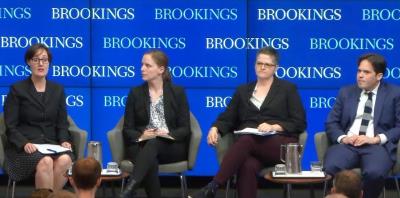Growth of 0.5 percent in the U.S. population from 2018 to 2019 representing 1.5 million people was the slowest annual rate since 1917 according to the Brookings Institution. This belies the claim that “we are full”. For the first time in decades the number of births minus the number of  deaths did not exceed one million according to Fortune. The Boomer generation is aging and their mortality rate will surely increase despite advances in medical care. In the case of West Virginia, Maine, New Hampshire and Vermont, deaths outnumbered births. There is a clear trend of migration to southern states with population losses in New York, Illinois, West Virginia and Connecticut. Overall, the northeast states lost 0.1 percent of their population from migration with southern states gaining 0.8 percent.
deaths did not exceed one million according to Fortune. The Boomer generation is aging and their mortality rate will surely increase despite advances in medical care. In the case of West Virginia, Maine, New Hampshire and Vermont, deaths outnumbered births. There is a clear trend of migration to southern states with population losses in New York, Illinois, West Virginia and Connecticut. Overall, the northeast states lost 0.1 percent of their population from migration with southern states gaining 0.8 percent.
Demographic changes have implications for food consumption, industrial productivity and above all maintaining the integrity of the Social Security system. Fewer contributors supporting an ever-increasing number of dependents will ultimately require a substantial infusion of public funds to maintain solvency. The system was established during the FDR Administration when life expectancy was considerably shorter, the average age of the population was lower and the ratio of contributors to dependents was higher than during in the third decade of the current century.
 It is evident that the deficit in U.S. births can be compensated by immigration. Unfortunately the last decade saw a decrease in migrants due to the great recession through the mid-2010s and more recently the consequence of restrictive immigration policies. Migration dropped from approximately one million in 2016 to 600,000 in 2018. Dr. William Frey of the Brookings Institution correctly observes that “immigrants tend to be younger and have children and they can make a population younger.”
It is evident that the deficit in U.S. births can be compensated by immigration. Unfortunately the last decade saw a decrease in migrants due to the great recession through the mid-2010s and more recently the consequence of restrictive immigration policies. Migration dropped from approximately one million in 2016 to 600,000 in 2018. Dr. William Frey of the Brookings Institution correctly observes that “immigrants tend to be younger and have children and they can make a population younger.”
It is evident that if the U.S. continues to have an aging population, apart from the issue of social security, we will have insufficient children to fill our schools and then universities and there will be a disinclination for our younger citizens to engage in manual labor, trades and the multitude of jobs required to maintain our society. Japan serves as a clear example of the result of a declining birth rate complicated by xenophobia and ethnic discrimination. The nation is forced to now take in temporary workers from Indonesia, Korea and the Philippines to perform manual work in industry and agriculture.
In a recent visit to egg-packing plants in Japan, I was intrigued by notices in Portuguese affixed to doors and walls. It was only after an hour spent in the first plant that it was recognized that many of the ethnic Japanese were in fact the third-generation of immigrants from Japan to Brazil. They had returned as guest workers and hopefully immigrants. These workers are apparently acceptable since they are regarded by the domestic population as being Japanese whereas society would reject Brazilians without this ethnicity.
It is evident that to maintain population growth the U.S. cannot rely only on the birth rate. We require a regular and steady infusion of immigrants preferably with skills and the ability to assimilate into our population. Even if the first generation reflects a different culture and lacks other than manual skills succeeding generations will take advantage of our free-enterprise and democratic system and demonstrate upward mobility. We obviously must do more to integrate immigrant minorities into the mainstream of U.S. agriculture and industry through incentives and training programs.
Japan and the Federation of Russia have declining and aging populations with attendant undesirable outcomes extending over the intermediate and long term. We should look to the nation of Israel that has welcomed migrants and refugees from their unfriendly and discriminatory home nations to be melded into a nation that stands out as a progressive and homogenous democracy unique on the subcontinent.
If we look back on our own history during the late 19th and early 20th centuries, the U.S. received the poor and oppressed of Europe. The second generation became Americans in every sense and so it must be going forward to the middle of the current century. Unfortunately there are no longer available Norwegians displaced from the rural areas of their native country willing to settle on the plains. There are no immigrants from Ireland forced to leave by famine and poverty to dig our canals and build our bridges as they did in the mid-19th century. To maintain population growth and an acceptable distribution of ages in our population we will have to be more accepting of qualified immigrants from Latin America and Asia to balance the disparity between births and deaths.